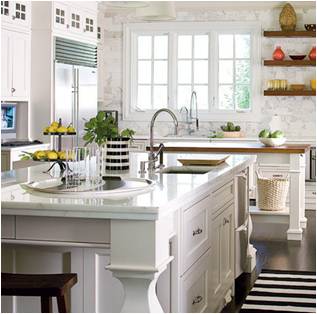 The ultra clean-looking, almost sanitary appearance of white marble countertops provides the benefit of brightening the surroundings where it happens to be installed.
The ultra clean-looking, almost sanitary appearance of white marble countertops provides the benefit of brightening the surroundings where it happens to be installed.
White natural marble, like white Carrara marble is not in short supply and can be less expensive than some other marble colors.
Another benefit of white marble — although a porous and softer selection when compared to other natural stones — is actually harder than darker colored marble varieties.
The darker the marble color, the more flaws and natural faults it has requiring more repair with epoxies, cements or dowels.
With that said, both polished white marble and that with a honed finish, because of its reflectivity, will show water rings, scratches, etches and stains more so than darker colors.
With darker colored marbles, although more expensive and softer than white, you get a benefit of more veining which helps to conceal any surface imperfections.
Getting a light or dark colored marble is always based on individual preference but know that white marble, especially in countertops, is going to take some extra maintenance.
White Marble Countertops Need More Care
If any color of marble makes a great case for marble sealing, it’s white marble. While there are NO marble sealers that will make a marble countertop completely impervious to moisture intrusion, it will buy you plenty of time to make sure spills get wiped up before they stain and mare the surface.
Using coasters under glasses or other drink cups, like coffee cups is also advisable for ANY marble countertops.
Acids like fruit juices, lemons and the like will etch the surface of a countertop and depending on the depth of the etch, may need the services of a professional to remove. Light surface etching can generally be buffed out with a good marble polish but the key to keeping a pristine appearance is to not let any offenders leave their mark to begin with.
In the case of purchasing a resale with scratched or etched white marble counter, the best thing to do initially is test the surface to see if it’s sealed. If it is than you can get about the business of removing any stains with the tips found HERE.
If the marble has not been sealed, the clean and thoroughly dry the marble surface first and then apply a quality sealer.
It is extremely important to ensure your marble is dry BEFORE applying a sealer because the last thing you want to do is trap moisture below the surface of your marble countertop.




